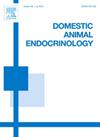Investigating hair cortisol dynamics in German Shepherd Dogs throughout pregnancy, lactation, and weaning phases, and its potential impact on the hair cortisol of offspring
IF 2.1
2区 农林科学
Q2 AGRICULTURE, DAIRY & ANIMAL SCIENCE
引用次数: 0
Abstract
Pregnancy, lactation, and weaning are crucial physiological stages in the life of bitches, directly affecting the physiological health of bitches and the growth and development of newborn puppies. This study aims to investigate the physiological stress of bitches during pregnancy, lactation, and weaning, as well as the effects of these changes on newborn puppies, by analyzing the variations in hair cortisol concentrations (HCCs) of bitches and their newborn offspring during different stages. This study selected 24 female German Shepherd dogs aged 2-3 years who were pregnant and giving birth for the first time and their 118 surviving newborn offspring as experimental subjects. Hair samples were collected from the right shoulder and neck of the bitches and their offspring at four key time points: the day of mating (T0), the day of delivery (T1/NT1), the first day of weaning (T2/NT2), and the 60th day after weaning (T3/NT3). The HCCs was detected by enzyme-linked immunosorbent assay (ELISA) to assess their physiological stress. The results showed that the maternal HCCs significantly increased during pregnancy and lactation, reaching a peak during lactation. The HCCs of puppies also significantly increased during the weaning period. Meanwhile, there was a significant but moderate correlation between the cortisol levels in maternal hair and puppies' hair during pregnancy and lactation. In addition, the maternal HCCs during pregnancy and lactation were affected by the litter size, the higher the litter size, the higher the hair cortisol level, while the cortisol levels in the hair of puppies were not affected by the litter size. Bitches may face higher physiological and psychological pressures during reproduction and nurturing offspring, especially when the litter size is large. At the same time, the physiological status of bitches may have a certain impact on puppies. Therefore, care and attention during pregnancy, lactation, and puppy weaning periods should be strengthened to ensure that bitches and puppies receive good feeding management and environmental support, maintain their physiological and psychological health, and further enhance animal welfare.
研究德国牧羊犬在妊娠期、哺乳期和断奶期毛发皮质醇的动态变化及其对后代毛发皮质醇的潜在影响
孕期、哺乳期和断奶期是母狗一生中至关重要的生理阶段,直接影响母狗的生理健康和新生幼犬的生长发育。本研究旨在通过分析母狗及其新生幼犬毛发皮质醇浓度(HCCs)在不同阶段的变化,探讨母狗在妊娠、哺乳和断奶期间的生理应激,以及这些变化对新生幼犬的影响。本研究选取24只2 ~ 3岁首次怀孕分娩的母系德国牧羊犬及其118只幸存的新生后代作为实验对象。在交配日(T0)、分娩日(T1/NT1)、断奶第一天(T2/NT2)和断奶后第60天(T3/NT3) 4个关键时间点采集母狗及其子代右肩颈毛发。采用酶联免疫吸附试验(ELISA)检测hcc,评估其生理应激。结果表明,妊娠期和哺乳期母体hcc明显升高,哺乳期达到高峰。幼犬的HCCs在断奶期间也显著增加。与此同时,母犬毛发中的皮质醇水平与怀孕和哺乳期幼犬毛发之间存在显著但中等的相关性。此外,母犬孕期和哺乳期的HCCs受产仔数的影响,产仔数越多,毛发皮质醇水平越高,而幼犬毛发皮质醇水平不受产仔数的影响。母狗在繁殖和哺育后代的过程中可能面临更高的生理和心理压力,特别是当产仔量较大时。同时,母狗的生理状态可能会对幼犬产生一定的影响。因此,应加强孕期、哺乳期和幼犬断奶期的护理和关注,确保母犬和幼犬得到良好的喂养管理和环境支持,保持其生理和心理健康,进一步提高动物福利。
本文章由计算机程序翻译,如有差异,请以英文原文为准。
求助全文
约1分钟内获得全文
求助全文
来源期刊

Domestic animal endocrinology
农林科学-奶制品与动物科学
CiteScore
5.50
自引率
4.80%
发文量
58
审稿时长
31 days
期刊介绍:
Domestic Animal Endocrinology publishes scientific papers dealing with the study of the endocrine physiology of domestic animal species. Those manuscripts utilizing other species as models for clinical or production problems associated with domestic animals are also welcome.
Topics covered include:
Classical and reproductive endocrinology-
Clinical and applied endocrinology-
Regulation of hormone secretion-
Hormone action-
Molecular biology-
Cytokines-
Growth factors
 求助内容:
求助内容: 应助结果提醒方式:
应助结果提醒方式:


